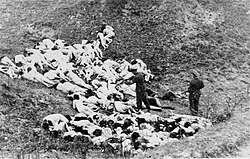| Kresy Wschodnie | |
|---|---|
| Part of the Second Polish Republic | |
 In the 1939 German-Soviet Molotov–Ribbentrop Pact the Eastern Borderlands (grey) were annexed directly into the Soviet Union. The Soviet gains east of the Curzon line devised in 1919 were confirmed (with minor adjustments in the areas around Białystok and Przemyśl) by the Western Allies at the Tehran Conference, the Yalta Conference and the Potsdam Conference. In 1945 most of Germany's territory east of the Oder–Neisse line (pink) was ceded to what remained of Poland (white), both of which would compose the newly created People's Republic of Poland | |
| Historical region | |
| Period | 1919–1939; 1945 |
| Area | Territories of Poland annexed by the Soviet Union in the Invasion of Poland of 1939 |
| Today part of | |
| Territorial evolution of Poland in the 20th century |
|---|
Eastern Borderlands [1] (Polish : Kresy Wschodnie), often simply Borderlands (Polish : Kresy, Polish pronunciation: [ˈkrɛsɨ] ) [a] was a historical region of the eastern part of the Second Polish Republic. The term was coined during the interwar period (1918–1939). Largely agricultural and extensively multi-ethnic with a Polish minority, [2] it amounted to nearly half of the territory of interwar Poland. Historically situated in the eastern Polish–Lithuanian Commonwealth, following the 18th-century foreign partitions it was divided between the Empires of Russia and Austria-Hungary, and ceded to Poland in 1921 after the Treaty of Riga. As a result of the post-World War II border changes, all of the territory was ceded to the Soviet Union, and today the area of Kresy is divided between Western Ukraine, Western Belarus, and south-eastern Lithuania.
Contents
- Extents
- Etymology
- History
- The Partitions of Poland
- The Pale of Settlement
- Economic decline of Kresy
- Between the World Wars
- During and after World War II
- Interwar population
- Largest cities and towns
- Polish minority after World War II
- Notable people
- A
- B
- C
- D
- F
- G
- H
- I
- J
- K
- L
- M
- N
- O
- P
- R
- S
- T
- W
- Z
- Cradle of Polish culture
- Present day
- In contemporary Poland
- Polish regional dialects
- See also
- Notes
- References
- Bibliography
- External links
The region gave rise to the Kresy myth, a collection of nostalgic views about the area. After the fall of Communism in Europe and dissolution of the Soviet Union a major economic conflict emerged about the real estate lost by Poland with the loss of Kresy.
In contemporary studies the term has been described as colonial and compared to similar other terms such as Russian "okrainy", which in the past was used by Russian imperial authorities to describe its borderlands, which included partitioned Poland. [3] [4] [5]












